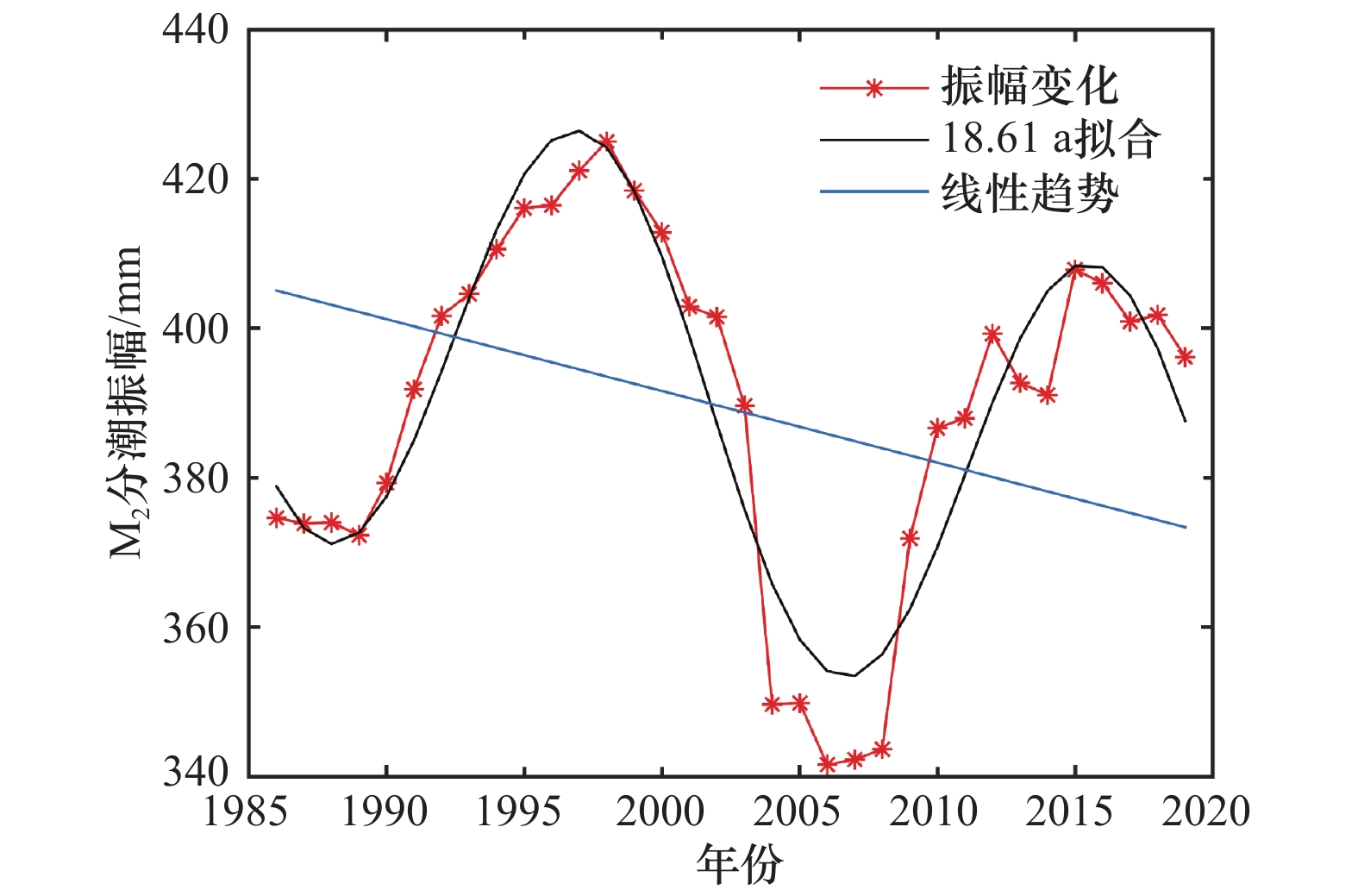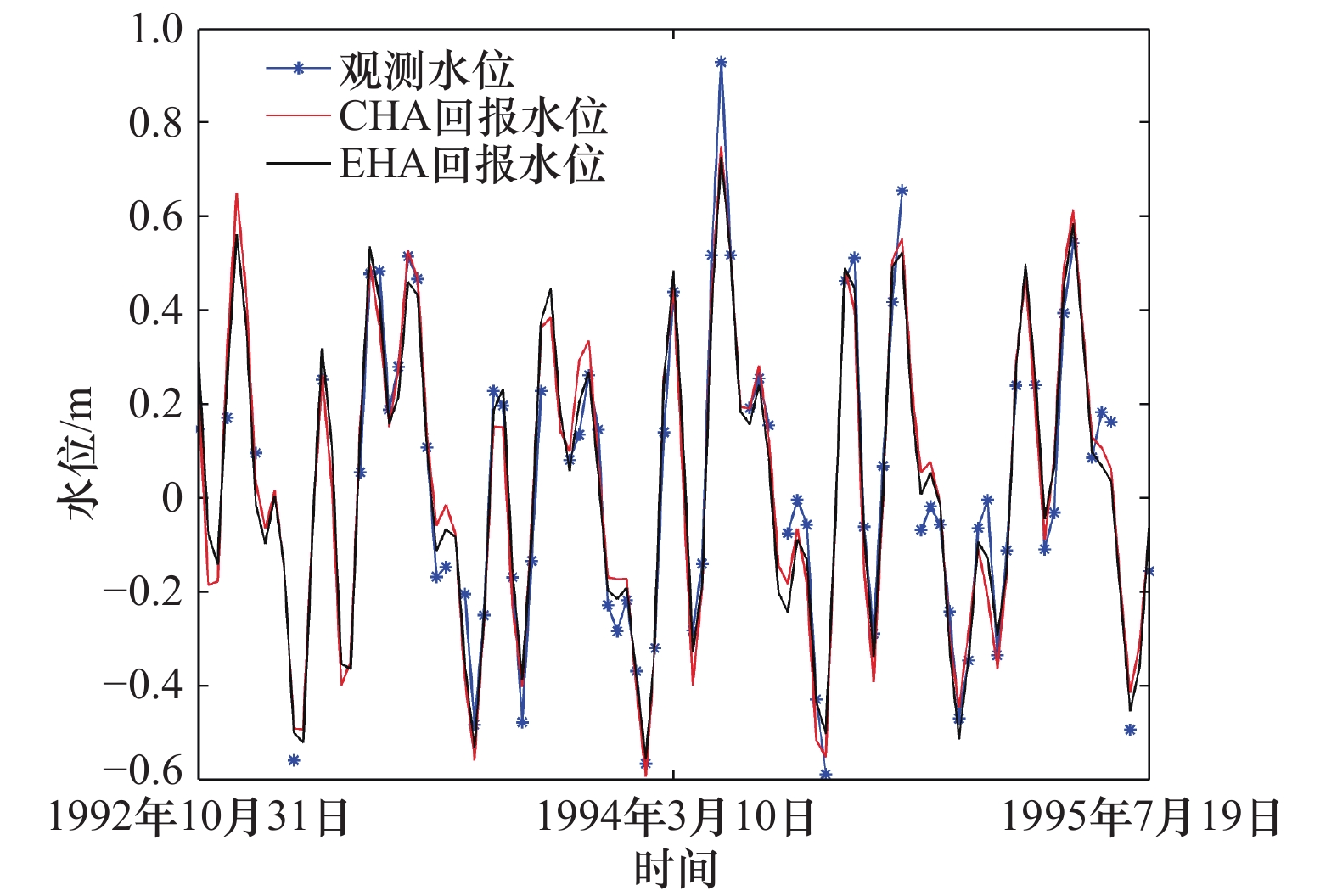The study of the trends of tidal amplitudes of major constituents in the South China Sea
-
摘要: 潮汐变化研究对于海洋工程、沿海地区洪涝灾害预防、海上交通等各个方面都有着重要的意义。由于验潮站都集中在近海,所以之前潮汐变化研究主要集中在近海海域。相比之下,深海地区由于长期高频水位观测的缺乏导致相关的潮汐变化研究非常少。基于近海验潮站数据和深海卫星高度计数据,本文首次用非平稳潮汐调和分析工具包S_TIDE提取了南海4大主要分潮(M2、S2、K1、O1)振幅的长期趋势。研究发现在南海大部分地区,4大主要分潮的振幅都是比较稳定的,不存在显著的上升趋势或下降趋势。在南海少部分地区4大主要分潮的振幅存在显著的趋势,最大的上升趋势可达2.91 mm/a,最大的下降趋势可达3.50 mm/a。该海域潮汐的长期趋势可能与内潮海表面信号的变化有关。卫星观测到的潮汐既包含正压潮,也包含内潮海表面信号。南海作为全球内潮活动最活跃的海域之一,其内潮海表面信号是非常显著的。而内潮对海洋层化的变化是非常敏感的,海洋层化的变化会影响内潮的生成、传播和耗散以及内潮在海表的显示,最终引起该海域潮汐振幅的长期趋势。Abstract: The study of tidal changes is of great significance in marine engineering, marine mapping as well as marine transportation. Because nearly all tide gauges are located in the coastal waters, previous studies mainly focus on tidal changes in the shallow waters. In the deep sea, due to the lack of long-term high-frequency sea level observations, tidal changes are remained unclear. Based on the tide gauge observations and satellite altimeter data, non-stationary tidal harmonic analysis toolbox S_TIDE to extract the long-term trend of amplitudes of four major constituents in the South China Sea is first used in this paper. Results show that in most areas of the South China Sea, the amplitudes of four major constituents are stable and have no significant positive or negative trends. In minor areas of the South China Sea, the amplitudes of four major constituents have significant trends. The largest positive trends can reach 2.91 mm/a and the largest negative trends can reach 3.50 mm/a. The long-term trends of tidal amplitudes in this area may be related to the change of the surface expression of internal tides. The tides observed by satellite contain not only barotropic tides but also the surface expression of internal tides. The internal tides as well as their surface expression in the South China Sea are strongest in the world. The changes of ocean stratification can influence the generation, propagation and dissipation of internal tides as well as their surface expression and eventually induce the long-term trends of tidal amplitudes in the South China Sea.
-
Key words:
- South China Sea /
- the long-term trend of tides /
- satellite altimeter /
- S_TIDE /
- internal tides
-
表 1 南海长期验潮站信息
Tab. 1 The information of long-term tide gauges in the South China Sea
站点名称 UHSLC编号 本文的编号 纬度 经度 年份跨度 CENDERING 320 1 5.27°N 103.19°E 1984−2015年 KUANTAN 322 2 3.98°N 103.43°E 1983−2015年 TIOMAN 323 3 2.81°N 104.14°E 1985−2015年 SEDILI 324 4 1.93°N 104.12°E 1986−2015年 KUKUP 325 5 1.33°N 103.44°E 1985−2015年 GETING 326 6 6.23°N 102.11°E 1986−2015年 KO LAK 328 7 11.80°N 99.82°E 1985−2019年 QUARRY BAY 329 8 22.30°N 114.22°E 1986−2019年 KAOHSIUNG 340 9 22.62°N 120.28°E 1980−2016年 MANILA 370 10 14.59°N 120.97°E 1984−2015年 KOTA KINABALU 386 11 5.98°N 116.07°E 1987−2015年 BINTULU 387 12 3.22°N 113.07°E 1992−2015年 SANDAKAN 389 13 5.81°N 118.07°E 1993−2015年 TANJONGPAGAR 699 14 1.26°N 103.85°E 1984−2016年 表 2 从长期验潮站得到的南海主要分潮振幅和平均海平面的趋势
Tab. 2 The trend of major constituents’ tidal amplitudes and mean sea level obtained from long-term tide gauges in the South China Sea
站点名称 M2分潮振幅趋势/(mm·a−1) S2分潮振幅趋势/(mm·a−1) K1分潮振幅趋势/(mm·a−1) O1分潮振幅趋势/(mm·a−1) 平均海平面趋势/(mm·a−1) CENDERING 0.17 − − − 3.41 KUANTAN 0.40 − − − 3.25 TIOMAN 0.33 − − − 3.20 SEDILI − − −0.39 − 2.75 KUKUP 0.44 0.39 − − 3.71 GETTING 0.58 0.26 0.31 0.14 3.27 KO LAK 0.14 − − − 5.98 QUARRY BAY −0.96 −0.45 −0.61 −0.50 1.99 KAOHSIUNG 0.30 − − − −0.47 MANILA − − 0.46 0.23 12.94 KOTA KINABALU − − − − 4.46 BINTULU − − − − 4.80 SANDAKAN − − − − 5.06 TANJONGPAGAR − −0.18 0.24 0.26 3.38 注:−代表趋势不显著。 表 3 从卫星高度计观测得到的南海中央深海海盆主要分潮振幅和平均海平面的趋势统计结果
Tab. 3 The trend of major constituents, tidal amplitudes and mean sea level in the central deep sea basin of South China Sea obtained from satellite altimeter data
分潮 趋势不显著的
点个数正趋势的
点个数负趋势的
点个数所有点趋势平均值/
(mm·a−1)所有点趋势最大值/
(mm·a−1)所有点趋势最小值/
(mm·a−1)M2 1 293 216 91 0.57 2.80 −1.61 S2 1 344 192 64 0.51 1.85 −1.94 K1 1 031 243 326 −0.17 2.91 −3.50 O1 1 417 61 122 −0.37 2.22 −1.93 平均海平面 0 1 600 0 5.61 10.55 1.29 -
[1] Woodworth P L. A survey of recent changes in the main components of the ocean tide[J]. Continental Shelf Research, 2010, 30(15): 1680−1691. doi: 10.1016/j.csr.2010.07.002 [2] Talke S A, Jay D A. Changing tides: the role of natural and anthropogenic factors[J]. Annual Review of Marine Science, 2020, 12: 121−151. doi: 10.1146/annurev-marine-010419-010727 [3] Doodson A T. Perturbations of harmonic tidal constants[J]. Proceedings of the Royal Society, London Mathematical, Physical and Engineering Sciences, 1924, 106(739): 513−526. [4] Godin G. Possibility of rapid changes in the tide of the Bay of Fundy, based on a scrutiny of the records from Saint John[J]. Continental Shelf Research, 1992, 12(2/3): 327−338. doi: 10.1016/0278-4343(92)90034-H [5] Godin G. Rapid evolution of the tide in the Bay of Fundy[J]. Continental Shelf Research, 1995, 15(2/3): 369−372. [6] Cartwright D E. Secular changes in the oceanic tides at Brest, 1711−1936[J]. Geophysical Journal International, 1972, 30(4): 433−449. doi: 10.1111/j.1365-246X.1972.tb05826.x [7] DiLorenzo J L, Huang Poshu, Thatcher M L, et al. Dredging impacts of Delaware estuary tides[C]//Proceedings of the 3rd International Conference Sponsored by the Waterway, Port, Coastal and Ocean Division, Estuarine and Coastal Modeling III. Oak Brook, IL: ASCE, 1993, 19: 86−104. [8] Flick R E, Murray J F, Ewing L C. Trends in United States tidal datum statistics and tide range[J]. Journal of Waterway, Port, Coastal, and Ocean Engineering, 2003, 129(4): 155−164. doi: 10.1061/(ASCE)0733-950X(2003)129:4(155) [9] Ray R D. Secular changes of the M2 tide in the Gulf of Maine[J]. Continental Shelf Research, 2006, 26(3): 422−427. doi: 10.1016/j.csr.2005.12.005 [10] Colosi J A, Munk W. Tales of the venerable Honolulu tide gauge[J]. Journal of Physical Oceanography, 2006, 36(4): 967−996. [11] Jay D A. Evolution of tidal amplitudes in the eastern Pacific Ocean[J]. Geophysical Research Letters, 2009, 36(4): L04603. [12] Ray R D. Secular changes in the solar semidiurnal tide of the western North Atlantic Ocean[J]. Geophysical Research Letters, 2009, 36(19): L19601. doi: 10.1029/2009GL040217 [13] Müller M. Rapid change in semi-diurnal tides in the North Atlantic since 1980[J]. Geophysical Research Letters, 2011, 38(11): L11602. [14] Winterwerp J C, Wang Z B. Man-induced regime shifts in small estuaries—I: theory[J]. Ocean Dynamics, 2013, 63(11): 1279−1292. [15] Feng Xiangbo, Tsimplis M N, Woodworth P L. Nodal variations and long-term changes in the main tides on the coasts of China[J]. Journal of Geophysical Research: Oceans, 2015, 120(2): 1215−1232. doi: 10.1002/2014JC010312 [16] Rodríguez-Padilla I, Ortiz M. On the secular changes in the tidal constituents in San Francisco Bay[J]. Journal of Geophysical Research: Oceans, 2017, 122(9): 7395−7406. doi: 10.1002/2016JC011770 [17] Devlin A T, Jay D A, Zaron E D, et al. Tidal variability related to sea level variability in the Pacific Ocean[J]. Journal of Geophysical Research: Oceans, 2017, 122(11): 8445−8463. doi: 10.1002/2017JC013165 [18] Devlin A T, Pan Jiayi, Lin Hui. Extended spectral analysis of tidal variability in the North Atlantic Ocean[J]. Journal of Geophysical Research: Oceans, 2019, 124(1): 506−526. doi: 10.1029/2018JC014694 [19] Ralston D K, Talke S, Geyer W R, et al. Bigger tides, less flooding: effects of dredging on barotropic dynamics in a highly modified estuary[J]. Journal of Geophysical Research: Oceans, 2019, 124(1): 196−211. doi: 10.1029/2018JC014313 [20] Pan Haidong, Guo Zheng, Lü Xianqing. Inversion of tidal open boundary conditions of the M2 constituent in the Bohai and Yellow Seas[J]. Journal of Atmospheric and Oceanic Technology, 2017, 34(8): 1661−1672. doi: 10.1175/JTECH-D-16-0238.1 [21] Green J A M, David T W. Non-assimilated tidal modeling of the South China Sea[J]. Deep-Sea Research Part I: Oceanographic Research Papers, 2013, 78: 42−48. doi: 10.1016/j.dsr.2013.04.006 [22] Gao Xiumin, Wei Zexun, Lü Xianqing, et al. Numerical study of tidal dynamics in the South China Sea with adjoint method[J]. Ocean Modelling, 2015, 92: 101−114. doi: 10.1016/j.ocemod.2015.05.010 [23] Fang Guohong, Kwok Y K, Yu Kejun, et al. Numerical simulation of principal tidal constituents in the South China Sea, Gulf of Tonkin and Gulf of Thailand[J]. Continental Shelf Research, 1999, 19(7): 845−869. doi: 10.1016/S0278-4343(99)00002-3 [24] Zu Tingting, Gan Jianping, Erofeeva S Y. Numerical study of the tide and tidal dynamics in the South China Sea[J]. Deep-Sea Research Part I: Oceanographic Research Papers, 2008, 55(2): 137−154. doi: 10.1016/j.dsr.2007.10.007 [25] 王延强, 仉天宇, 朱学明. 基于18.6年卫星高度计资料对南海潮汐的分析与研究[J]. 海洋预报, 2014, 31(2): 35−40.Wang Yanqing, Zhang Tianyu, Zhu Xueming. Tidal characteristics analysis in the South China Sea by 18.6 years satellite altimetry data[J]. Marine Forecasts, 2014, 31(2): 35−40. [26] 雷宁, 付延光, 杨龙, 等. 一种建立南海浅海海域高精度潮汐模型方法的研究[J]. 海洋科学进展, 2016, 34(3): 370−376.Lei Ning, Fu Yanguang, Yang Long, et al. A method of constructing high precision tide model for shallow water in the South China Sea[J]. Advances in Marine Science, 2016, 34(3): 370−376. [27] 赵玖强, 张艳伟, 刘志飞, 等. 南海北部深海潮汐的季节性变化特征[J]. 中国科学: 地球科学, 2019, 62(4): 671−683. doi: 10.1007/s11430-017-9315-7Zhao Jiuqiang, Zhang Yanwei, Liu Zhifei, et al. Seasonal variability of tides in the deep northern South China Sea[J]. Science China (Terrae), 2019, 62(4): 671−683. doi: 10.1007/s11430-017-9315-7 [28] 刘旭华, 杨俊钢, 刘全生, 等. 基于长时序T/P和Jason系列卫星高度计数据的中国南海潮汐信息提取研究[J]. 地球物理学进展, 2020, 35(2): 438−444.Liu Xuhua, Yang Jungang, Liu Quansheng, et al. Extraction of tidal information in the South China Sea base on long time series of T/P and Jason series altimeter data[J]. Progress in Geophysics, 2020, 35(2): 438−444. [29] Pan Haidong, Lü Xianqing, Wang Yingying, et al. Exploration of tidal-fluvial interaction in the Columbia river estuary using S_TIDE[J]. Journal of Geophysical Research: Oceans, 2018, 123(9): 6598−6619. doi: 10.1029/2018JC014146 [30] Wang Daosheng, Pan Haidong, Jin Guangzhen, et al. Seasonal variation of the principal tidal constituents in the Bohai Sea[J]. Ocean Science, 2020, 16(1): 1−14. doi: 10.5194/os-16-1-2020 [31] 潘海东. S_TIDE工具包使用中文教程1.0[R]. 青岛: 中国海洋大学, 2019.Pan Haidong. S_TIDE toolbox tutorials (in Chinese)[R]. Qingdao: Ocean University of China, 2019. [32] Pawlowicz R, Beardsley B, Lentz S. Classical tidal harmonic analysis including error estimates in MATLAB using T_TIDE[J]. Computers & Geosciences, 2002, 28(8): 929−937. [33] Jin Guangzhen, Pan Haidong, Zhang Qilin, et al. Determination of harmonic parameters with temporal variations: An enhanced harmonic analysis algorithm and application to internal tidal currents in the South China Sea[J]. Journal of Atmospheric and Oceanic Technology, 2018, 35(7): 1375−1398. doi: 10.1175/JTECH-D-16-0239.1 [34] Guo Zheng, Pan Haidong, Fan Wei, et al. Application of surface spline interpolation in inversion of bottom friction coefficients[J]. Journal of Atmospheric and Oceanic Technology, 2017, 34(9): 2021−2028. doi: 10.1175/JTECH-D-17-0012.1 [35] Pan Haidong, Zheng Quanxin, Lü Xianqing. Temporal changes in the response of the nodal modulation of the M2 tide in the Gulf of Maine[J]. Continental Shelf Research, 2019, 186: 13−20. doi: 10.1016/j.csr.2019.07.007 [36] Familkhalili R, Talke S A. The effect of channel deepening on tides and storm surge: A case study of Wilmington, NC[J]. Geophysical Research Letters, 2016, 43(17): 9138−9147. doi: 10.1002/2016GL069494 [37] Chant R J, Sommerfield C K, Talke S A. Impact of channel deepening on tidal and gravitational circulation in a highly engineered estuarine basin[J]. Estuaries and Coasts, 2018, 41(6): 1587−1600. doi: 10.1007/s12237-018-0379-6 [38] Devlin A T, Jay D A, Talke S A, et al. Can tidal perturbations associated with sea level variations in the western Pacific Ocean be used to understand future effects of tidal evolution?[J]. Ocean Dynamics, 2014, 64(8): 1093−1120. doi: 10.1007/s10236-014-0741-6 [39] Devlin A T, Jay D A, Talke S A, et al. Coupling of sea level and tidal range changes, with implications for future water levels[J]. Scientific Reports, 2017, 7: 17021. doi: 10.1038/s41598-017-17056-z [40] Schindelegger M, Green J A M, Wilmes S B, et al. Can we model the effect of observed sea level rise on tides?[J]. Journal of Geophysical Research: Oceans, 2018, 123(7): 4593−4609. doi: 10.1029/2018JC013959 [41] 王佳莹, 方国洪, 王永刚. 南海海面风场、高度场和温度场近十年的变化趋势及年际变化特征[J]. 海洋科学进展, 2017, 35(2): 159−175.Wang Jiaying, Fang Guohong, Wang Yonggang. Trends and interannual variability of the South China Sea surface winds, surface height and surface temperature in the recent decade[J]. Advances in Marine Science, 2017, 35(2): 159−175. -





 下载:
下载:







